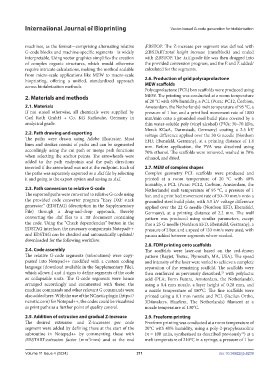Page 219 - v11i4
P. 219
International Journal of Bioprinting Vector-based G-code generation for biofabrication
machines, as the format—comprising alternating relative ;EBSTOP. The Z-increase per segment was defined with
G-code blocks and machine-specific segments—is widely ;ZBSTART:total height increase (mm/block) and ended
interpretable. Using vector graphics simplifies the creation with ;ZBSTOP. The .txt/.gcode file was then dragged into
of complex organic structures, which would otherwise the provided conversion program, and the E and Z added/
require intricate calculations, making the method scalable calculated for the segments.
from micro-scale applications like MEW to macro-scale
bioprinting, offering a unified, standardized approach 2.6. Production of grid polycaprolactone
across biofabrication methods MEW scaffolds
Polycaprolactone (PCL) box scaffolds were produced using
2. Materials and methods MEW. The printing was conducted at a room temperature
of 20 °C with 40% humidity, a PCL (Purac PC12, Corbion,
2.1. Materials Amsterdam, the Netherlands) melt temperature of 95 °C, a
If not stated otherwise, all chemicals were supplied by pressure of 1 bar, and a print bed movement rate of 1000
Carl Roth GmbH + Co. KG Karlsruhe, Germany in mm/min onto a grounded steel build plate covered by a
analytical grade. thin water-soluble poly (vinyl alcohol) (PVA; 30–70 kDa,
Merck KGaA, Darmstadt, Germany) coating a 2.5 kV
2.2. Path drawing and exporting voltage difference applied over the 30 G needle (Nordson
The paths were drawn using Adobe Illustrator. Most EFD, Ebensfeld, Germany), at a printing distance of 1.4
lines and strokes consist of paths and can be segmented mm. Before application, the PVA was dissolved using
accordingly using the cut path or merge path functions 70% ethanol. The scaffolds were removed, washed in 70%
when selecting the anchor points. The arrowheads were ethanol, and dried.
added to the path endpoints and the path directions
inverted if the arrowhead was not at the endpoint. Each of 2.7. MEW of complex shapes
the paths was separately exported as a .dxf file by selecting Complex geometry PCL scaffolds were produced and
it and going to the export option and saving as .dxf. printed at a room temperature of 20 °C with 40%
humidity, a PCL (Purac PC12, Corbion, Amsterdam, the
2.3. Path conversion to relative G-code Netherlands) melt temperature of 95 °C, a pressure of 1
The exported paths were converted to relative G-code using bar, and a print bed movement rate of 50–70 mm/s onto a
the provided code converter program “Easy DXF stack grounded steel build plate, with 3.5 kV voltage difference
generator” (EDSTAG) (description in the Supplementary applied over the 22 G needle (Nordson EFD, Ebensfeld,
File) through a drag-and-drop approach, thereby Germany), at a printing distance of 2.2 mm. The wolf
converting the .dxf files to a .txt document containing pattern was produced using similar parameters, except
the code. Using the “Check dependencies” button in the that a 25 G needle (Nordson EFD, Ebensfeld, Germany), a
EDSTAG interface, the necessary components Notepad++ pressure of 2 bar, and a speed of 120 mm/s were used, with
and EDSTAG can be checked and automatically updated/ pauses added between segments where needed.
downloaded for the following workflow.
2.8. FDM printing onto scaffolds
2.4. Code assembly The scaffolds were laser-cut based on the red-drawn
The relative G-code segments (subroutines) were copy- pattern (Rayjet, Trotec, Plymouth, MA, USA). The speed
pasted into Notepad++ modified with a custom coding and intensity of the laser were varied to achieve a complete
language (download available in the Supplementary File), separation of the remaining scaffold. The scaffolds were
which allows ;{ and ;} signs to define segments of the code then reinforced as previously described, with polylactic
23
as collapsable units. The G-code segments were hence acid (PLA; Form Futura, Amsterdam, the Netherlands),
arranged accordingly and commented with these; the using a 0.4 mm nozzle, a layer height of 0.28 mm, and
machine commands and other relevant G commands were a nozzle temperature of 180°C. The fine scaffolds were
also added here. With the use of the NCnetic plugin (https:// printed using a 0.1 mm nozzle and PCL (Facilan Ortho,
ncnetic.com) for Notepad++, the codes could be visualized 3D4makers, Haarlem, The Netherlands) filament at a
as print paths as a further point of quality control. nozzle temperature of 130°C.
2.5. Addition of extrusion and gradual Z-increase 2.9. Freeform printing
The desired extrusion and Z-increases per code Freeform printing was conducted at a room temperature of
segment were added by defining these at the start of the 20°C with 40% humidity, using a poly-2-propyloxazoline
subroutine in Notepad++ by commenting these with (n = 100 units, synthesized as described previously ) at a
24
;EBSTART:extrusion factor (mm /mm) and at the end melt temperature of 210°C in a syringe, a pressure of 1 bar
3
Volume 11 Issue 4 (2024) 211 doi: 10.36922/ijb.6239

